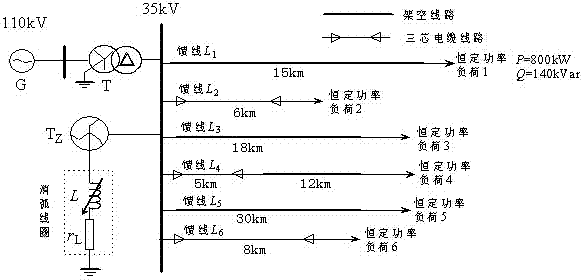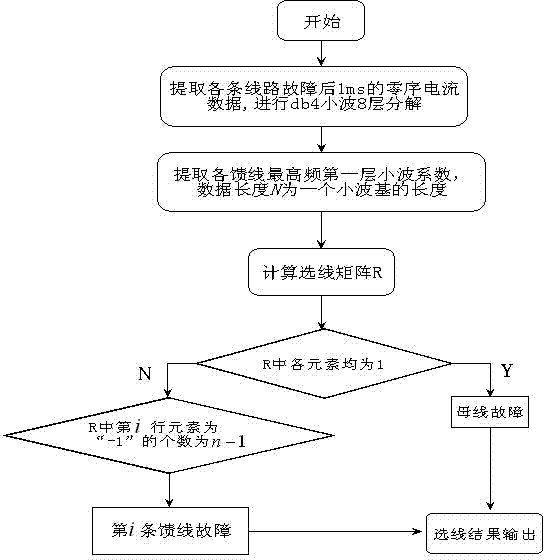Distribution network fault line selection method based on correlation analysis of zero modal current wavelet coefficients
A technology of wavelet coefficient and fault line selection, applied in the direction of fault location, etc., can solve problems such as extended power outage time, line power outage, operation overvoltage and resonance overvoltage impact on power supply network, etc., to avoid the influence of compensation and overcome easy The effect of noise interference
- Summary
- Abstract
- Description
- Claims
- Application Information
AI Technical Summary
Problems solved by technology
Method used
Image
Examples
Embodiment 1
[0038] Embodiment 1: as figure 1 As shown in the distribution network structure, set the feeder L 1An AG fault occurs 5 kilometers away from the beginning, the transition resistance is 20Ω, and the initial phase angle of the fault is 90°.
[0039] (1) Take the sampling rate as 1MHz, and extract the zero-mode current traveling wave in the 0.2ms short-time window of each line for wavelet decomposition. Here, take the db4 wavelet base as an example to illustrate, and select the high-frequency first-scale wavelet coefficient as the research object ,like image 3 shown;
[0040] (2) Calculate the relative polarity of the high-frequency first-scale wavelet coefficients of each feeder line with a total of 6 lines according to formula (1);
[0041] (3) Calculate according to formula (2) to form a distribution network fault line selection matrix R .
[0042]
[0043] (3)
[0044] matrix The number of "-1" in the first row of elements is 5,...
Embodiment 2
[0045] Embodiment 2: as figure 1 As shown in the distribution network structure, set the feeder L 2 An AG fault occurs 4 kilometers away from the beginning, the transition resistance is 10Ω, and the initial phase angle of the fault is 90°.
[0046] (1) Take the sampling rate as 1MHz, and extract the zero-mode current traveling wave in the 0.2ms short-time window of each line for wavelet decomposition. Here, take the db4 wavelet base as an example to illustrate, and select the high-frequency first-scale wavelet coefficient as the research object ;
[0047] (2) Calculate the relative polarity of the high-frequency first-scale wavelet coefficients of each feeder line with a total of 6 lines according to formula (1);
[0048] (3) Calculate according to formula (2) to form a distribution network fault line selection matrix R .
[0049]
[0050] (4)
[0051] matrix The number of "-1" in the second row element is 5, according to figure ...
Embodiment 3
[0052] Embodiment 3: as figure 1 In the distribution network structure shown, set the AG fault on the bus, the transition resistance is 10Ω, and the initial phase angle of the fault is 90°.
[0053] (1) Take the sampling rate as 1MHz, and extract the zero-mode current traveling wave in the 0.2ms short-time window of each line for wavelet decomposition. Here, take the db4 wavelet base as an example to illustrate, and select the high-frequency first-scale wavelet coefficient as the research object ;
[0054] (2) Calculate the relative polarity of the high-frequency first-scale wavelet coefficients of each feeder line with a total of 6 lines according to formula (1);
[0055] (3) Calculate according to formula (2) to form a distribution network fault line selection matrix R .
[0056]
[0057] (5)
[0058] matrix Any element in is "1", according to figure 2 The flow chart shown shows that the bus fails.
[0059] against figure 1 The...
PUM
| Property | Measurement | Unit |
|---|---|---|
| Transition resistance | aaaaa | aaaaa |
Abstract
Description
Claims
Application Information
 Login to View More
Login to View More - Generate Ideas
- Intellectual Property
- Life Sciences
- Materials
- Tech Scout
- Unparalleled Data Quality
- Higher Quality Content
- 60% Fewer Hallucinations
Browse by: Latest US Patents, China's latest patents, Technical Efficacy Thesaurus, Application Domain, Technology Topic, Popular Technical Reports.
© 2025 PatSnap. All rights reserved.Legal|Privacy policy|Modern Slavery Act Transparency Statement|Sitemap|About US| Contact US: help@patsnap.com



